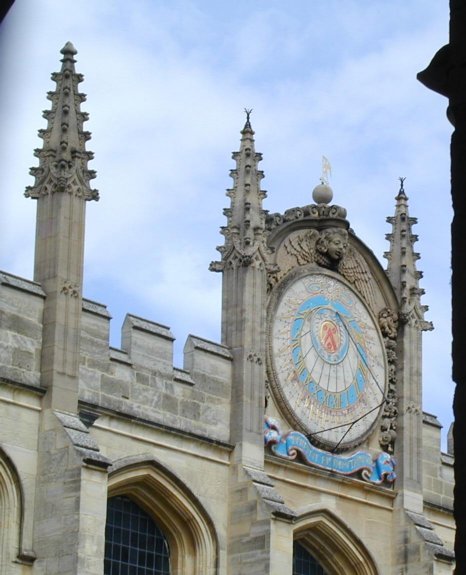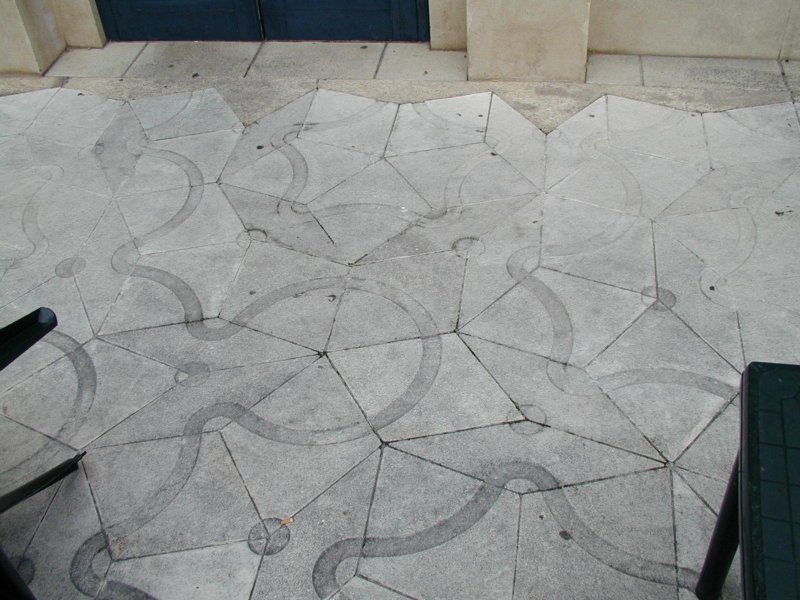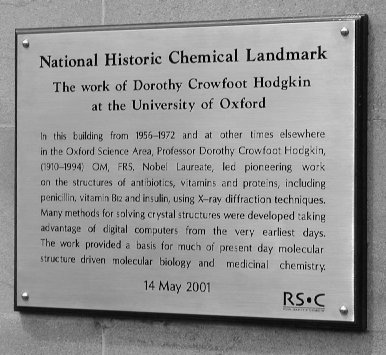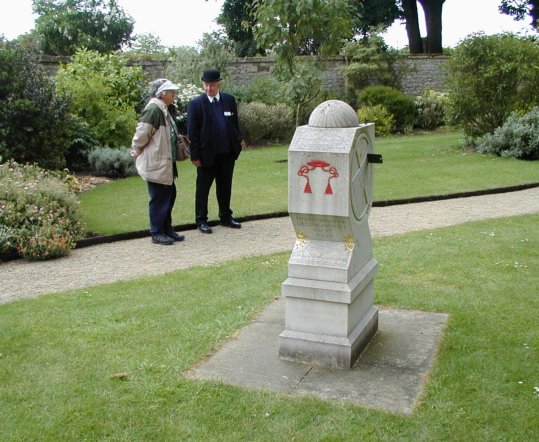
Figure 1 shows the next sundial on the walk,
this one is in the Great Quad of All Souls, designed by Christopher Wren.
The Oxford Science Walk. text Sophie Huxley,
illustrations Edith Gollnast
Published 1993 20 pages ISBN 0 9522671 0 1 by 'Science Walk Publications'
Abstract
This booklet describes a walk around Oxford looking at places associated
with scientists from the time of the founding of the University in the
thirteenth century to modern science in the twentieth. The places are mostly
buildings where scientists worked or memorials but the only scientific
instruments to be seen are inside the Museums. There is a brief paragraph
about the achievements of each scientist and directions how to get from one
place to the next.
Availability
The booklet is available from the Oxford Tourist Information Centre, some of
the Museums and the bookshops (e.g.The Ashmolean Musuem or Blackwells) in
the City. It has now been mounted on the website of the Museum of the
History of Science.
http://www.mhs.ox.ac.uk/features/walk/index.htm
where you can take a virtual walk by clicking on a map on the screen and
then printing the web pages. If you have a fast connection to the Internet
this site is tolerable, if you have not, you will find yourself waiting a
long time to download images which merely have text in them. If you turn off
the images, the site is unusable. It is a pity that the creator of the Web
pages did not take the opportunity to update the walk with sites of erected
more recently. The booklet may also be ordered from the Museum of the
History of Science price £3.95 inc of Postage & Packing. It is a
convenient format (size 125mm x 215mm) and easy to carry around on the walk.
Getting to and around Oxford
Oxford is well served by public transport; it is probably best to arrive by
train. Driving in Oxford is a nightmare of one way streets, pedestrian
precincts and traffic jams. The central car parks are expensive and often
full; the 'Park and Ride' large car parks on the outskirts of the City are
no longer free and the price of a bus ticket to the centre seems to go up
every few months. Once there you can buy one day bus 'Rover tickets' which
allow you to take any bus within the city limits, or you can get a ticket
for the open topped tourist bus and get on and off anywhere on its route.
Undergraduates cycle on the 'cycle tracks' denoted with green paint on the
edges of many of the roads, but there are few cycle parks so it is probably
better to walk. This can be tiring; fortunately there are many coffee shops
where you can rest to plan the rest of your walk, or pubs with historical
connections, frequented by authors such as C.S.Lewis whose science fiction
novels include 'Out of the Silent Planet' or where Colin Dexter's 'Inspector
Morse' liked to drink his pint of beer.
The authors state 'there is about an hour of actual walking', but I found that if you want to examine the places in detail it takes much longer than that, even if you know your way around Oxford some of the memorials are hard to find, so perhaps plan to spend a weekend there. Some sites can be seen at any time, others are inside colleges which are only open to visitors in the afternoons. There is a list of Museums and their opening times on the back page, but it is best to check these in advance either on the world wide web or at the tourist information centre and then plan your route.
Starting the walk
The first page has a useful sketch map with the walking route marked on it;
each site has a number which is shown on the map and in the booklet. Helpful
directions are given explaining how to get from one site to the next and
where to look for the interesting memorial. You can start anywhere; however
the booklet begins at the Botanical Gardens, probably because the author,
Sophie Huxley, is a biologist and a descendent of the T.H.Huxley who in the
nineteenth century confronted Samuel Wilberforce, Bishop of Oxford in a
debate in the University Museum on the validity of the theory of evolution
and the alternative story of creation in the Bible, the so-called 'Apes and
Angels' debate.
After looking in the Gardens and the memorial to the discoverers of penicillin I went into the University Parks to look for the plaque in honour of James Sadler, the first English aeronaut who flew in a hot air balloon in 1784. This is where I found that the elegant line drawings which illustrate this booklet are not all true representations of the memorials. James Sadler's memorial has a small balloon on it, but it is not as elegant as the one drawn in the booklet.
Sundials abound in Oxford which is strange because down in the Thames valley
the skies are often grey and overcast. The first one mentioned in the
booklet is that constructed in 1629 on the external wall of Merton College
Chapel which uses a brass bullet set in the corner of the adjacent buttress
as a gnomon.
It is not known who made it, either John Bainbridge, first
Savilian Professor of Astronomy or Henry Briggs, who succeeded Sir Henry
Savile as Professor of Geometry. Memorials to both men can be found in the
College Chapel.

Perhaps the skies were clearer in the days when the Radcliffe Observatory was built in 1773. There are no telescopes there now, it is used by Green College and is closed to visitors. It can be seen just to the North of the Radcliffe Infirmary in Woodstock Road.
Other scientists mentioned in the booklet which I do not have space to describe in detail are: Robert Boyle and Robert Hooke, Edmund Halley, Dorothy Hodgkin and numerous biologists.
The Museum of the History of Science in Broad Street and the University Museum in Parks Road
(http://www.oum.ox.ac.uk/ with a useful set of links to other Museums) are well worth visiting; you can easily spend a whole afternoon in either of them.
More recent sites not mentioned in the booklet

Fig2:
Roger Penrose was a fellow of Wadham College and when the undergraduates
wanted an extension to their patio bar, he persuaded the college to decorate
it with a 'penrose tiling' of kites and darts as shown
in the photograph.The 'tile the plane' in an irregular manner.
 |
Figure 3: Further along Parks Road near the pedestrian crossing at South Parks Road on the wall of the entrance to the Chemistry building is a new memorial to the work of the Nobel prize winning crystallographer Dorothy Hodgkin, which was unveiled in May 2001 by the Royal Society of Chemistry. |
Continuing along Parks Road one reaches the Physics Department and the two buildings of the Clarendon laboratory, where much pioneering research in low temperature physics was carried out between the World Wars in the twentieth century. The latest building between the 2 older Clarendon buildings is the Sir Martin Wood Lecture theatre, donated by the founder of Oxford Instruments which specialises in the production of high field low temperature magnets.
If you have children with you on your walk they may like to visit 'CuriOxCity' a 'hands on' interactive exhibition for young people in George Street near the Old Fire Station.

Twentieth century industry is represented by a small plaque on the wall at
first floor level near the Law Courts which reads "William Morris, Motor
manufacturer and trader".
I enjoyed this walk very much and would be happy to advise members who want
to walk along it for themselves.
Kate Crennell
February 2002
kmcrennell@physics.org